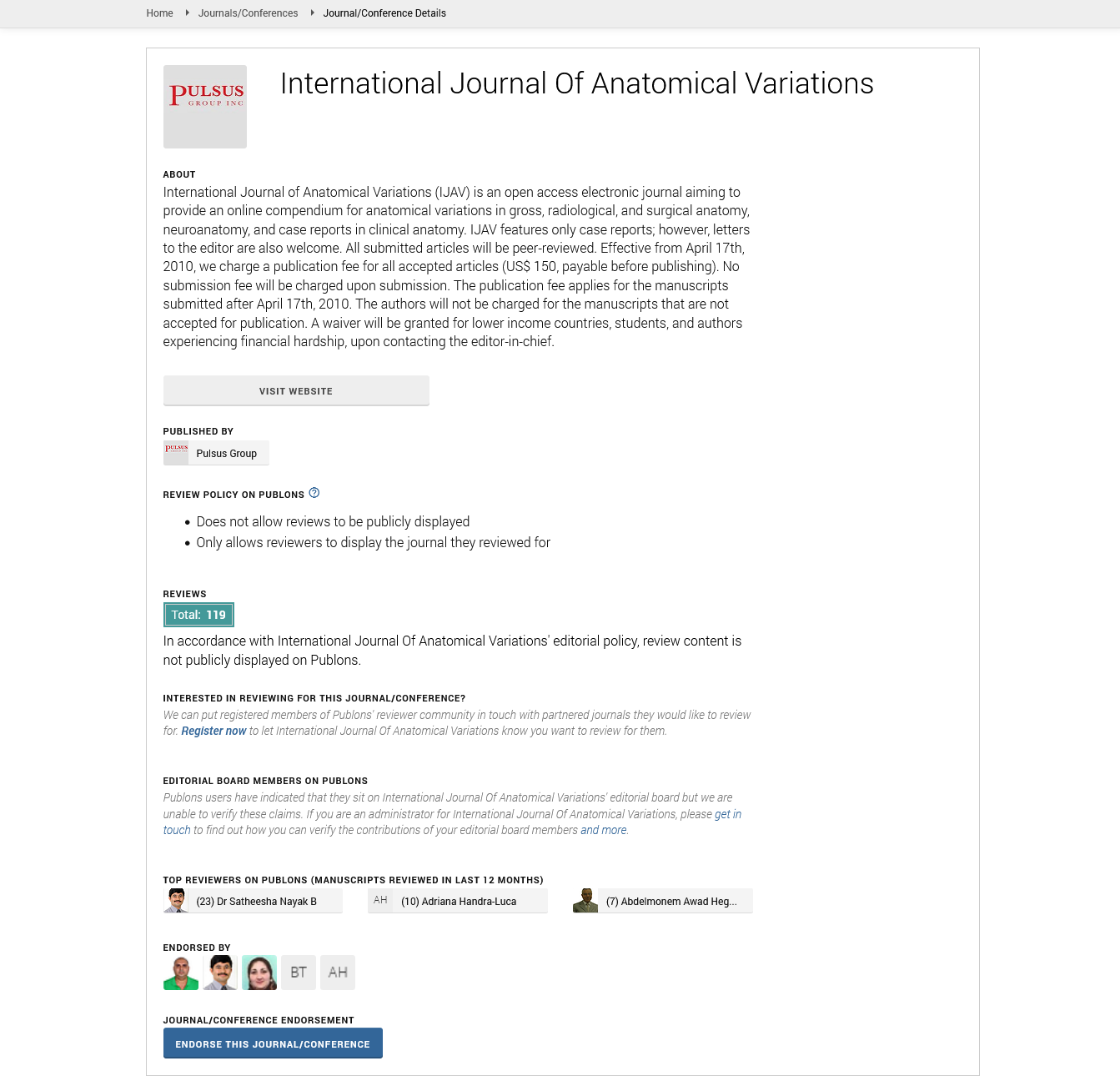Accessory Obturator Nerve and Its Role in Hip Joint Function
Received: 01-Nov-2024, Manuscript No. ijav-24-7340; Editor assigned: 04-Nov-2024, Pre QC No. ijav-24-7340; Reviewed: 18-Nov-2024 QC No. ijav-24-7340; Revised: 25-Nov-2024, Manuscript No. ijav-24-7340; Published: 30-Nov-2024, DOI: 10.37532/1308-4038.17(11).460
Citation: Blackwood Z. Accessory Obturator Nerve and Its Role in Hip Joint Function. Int J Anat Var. 2024;17(11): 689-690.
This open-access article is distributed under the terms of the Creative Commons Attribution Non-Commercial License (CC BY-NC) (http://creativecommons.org/licenses/by-nc/4.0/), which permits reuse, distribution and reproduction of the article, provided that the original work is properly cited and the reuse is restricted to noncommercial purposes. For commercial reuse, contact reprints@pulsus.com
Abstract
The accessory obturator nerve (AON) is a relatively uncommon anatomical variation of the lumbar plexus, typically arising from the L3 and L4 spinal nerves. Though it is present in a minority of the population, the AON plays a significant role in the motor and sensory innervation of the hip joint and surrounding structures. This article aims to explore the anatomy, prevalence, and variations of the AON, as well as its clinical significance in hip joint function. The role of the AON in the hip joint’s stability, particularly its involvement in adduction and flexion movements, will be examined. Additionally, the implications of AON variations for surgical procedures, nerve injuries, and diagnostic assessments related to hip function are discussed.
Keywords
Accessory obturator nerve; Hip joint; Lumbar plexus; Nerve variations; Motor innervation; Sensory innervation; Surgical anatomy; Hip function
INTRODUCTION
The obturator nerve, arising from the lumbar plexus (L2-L4), is a primary contributor to the motor and sensory innervation of the hip and thigh. Its main role involves the innervation of the adductor muscles of the hip and the medial skin of the thigh. However, an anatomical variation known as the accessory obturator nerve (AON) is present in a subset of individuals. The AON typically originates from the L3 and L4 spinal nerves, but it can also arise from the L2 spinal nerve in some cases. This variation is clinically significant, particularly in understanding the innervation of the hip joint and the potential consequences in cases of nerve injury, nerve compression, or surgical procedures involving the pelvis and hip region. The accessory obturator nerve is relatively uncommon, and its functional contributions to the hip joint and surrounding musculature are not as well understood as the primary obturator nerve. Nonetheless, it plays an essential role in the movement and stability of the hip joint, particularly in flexion and adduction. Variations in the course and branching of the AON can lead to different clinical presentations and should be carefully considered in clinical and surgical settings [1].
ANATOMY OF THE ACCESSORY OBTURATOR NERVE
The obturator nerve usually originates from the anterior branches of the L2-L4 ventral rami of the lumbar plexus. The AON is a variant nerve, most commonly arising from the L3 and L4 spinal nerves. It typically passes inferiorly, anterior to the psoas major muscle, and joins the obturator nerve proper or travels independently to supply motor and sensory innervation to the hip joint and surrounding structures.
The AON typically contributes motor fibers to the hip joint, particularly the adductor muscles. These muscles play a crucial role in stabilizing the hip during movements such as walking, running, and standing. In addition to motor function, the AON also provides sensory innervation to the skin over the medial thigh, assisting in proprioception and contributing to the overall function of the hip.
Not all individuals have an AON, and its presence and course can vary. In some individuals, the AON may be a small branch, whereas, in others, it may be more prominent. Its relationship to the obturator nerve proper and its effect on the hip joint function depend on its anatomical variations [3-10].
VARIATIONS IN THE ACCESSORY OBTURATOR NERVE
The prevalence of the accessory obturator nerve is estimated to be around 20-30% in the general population, though some studies report a lower incidence. Its development and presentation can vary widely between individuals. In some cases, the AON may be present as a distinct nerve, whereas, in others, it may be a small branch arising from the main obturator nerve trunk. This variability can influence the function of the hip joint and may alter the clinical presentation in cases of nerve injury or compression.
One important variation of the AON is its point of origin. While it most commonly arises from the L3 and L4 spinal nerves, it can occasionally have contributions from the L2 spinal nerve. Furthermore, the AON’s course can differ from individual to individual; it may travel anterior or posterior to the hip joint, or it may join with the main obturator nerve trunk or remain independent. This variation in the nerve's course can have significant implications for both the function of the hip joint and for surgical interventions that involve the pelvis and hip.
The AON may also demonstrate variations in its branching pattern. In some cases, it may provide additional branches to the muscles of the hip, including the pectineus or the adductors, whereas in others, its role may be limited to the sensory innervation of the medial thigh. These variations should be considered when evaluating patients with hip joint dysfunction or nerve-related complaints.
ROLE OF THE ACCESSORY OBTURATOR NERVE IN HIP JOINT FUNCTION
The primary role of the accessory obturator nerve is to contribute motor innervation to muscles that play a crucial role in the function and stability of the hip joint. These muscles are primarily involved in adduction, flexion, and internal rotation of the hip.
Adduction of the Hip Joint: One of the most important functions of the AON is its contribution to the adductor muscles of the hip. The adductor muscles, including the adductor longus, adductor brevis, and adductor magnus, are responsible for moving the leg toward the midline of the body. These muscles are crucial in stabilizing the pelvis and providing controlled movement during walking and running. The AON provides motor innervation to these muscles, particularly the adductor longus and the pectineus, which are key muscles in maintaining hip stability during dynamic movements.
Flexion of the Hip Joint: The AON also contributes to the flexion of the hip joint, a movement essential for activities such as sitting, climbing stairs, and lifting the leg. The pectineus muscle, which is innervated by the AON, plays an important role in hip flexion. This function is particularly important in maintaining functional mobility and balance, and any impairment of the AON can lead to difficulties in performing these movements.
Proprioception and Sensory Function: In addition to its motor functions, the AON also provides sensory innervation to the skin over the medial aspect of the thigh. This sensory input contributes to the proprioceptive feedback necessary for coordinated movement and balance. It helps the body perceive the position of the hip joint and thigh, thereby aiding in the control of hip movements during daily activities.
Stability During Weight-Bearing Activities: The muscles innervated by the AON contribute significantly to the overall stability of the hip joint during weight-bearing activities, such as standing, walking, and running. The adductor muscles work synergistically with other muscle groups to maintain the integrity of the hip joint during these tasks. The AON’s role in stabilizing the pelvis and assisting in weight transfer during dynamic movements cannot be overstated, as it helps prevent excessive strain on the hip joint.
CLINICAL IMPLICATIONS OF ACCESSORY OBTURATOR NERVE VARIATIONS
Although the accessory obturator nerve is relatively uncommon, its anatomical variations can have important clinical implications. For instance, the AON’s contribution to hip joint function means that any injury or compression of the nerve could result in motor deficits, including weakness in hip adduction and flexion. This could affect the patient's ability to perform normal daily activities, particularly those that require coordination and strength in the lower limb.
Surgical Considerations: Surgical procedures in the pelvic and hip region, such as hip arthroplasty or hernia repairs, can risk injury to the AON. Given the variation in the nerve’s course and its proximity to other vital structures, inadvertent damage to the AON can result in post-surgical motor deficits, such as weakened adduction or difficulty with hip flexion. Therefore, surgeons must be aware of the potential presence of an accessory obturator nerve when performing surgeries in the region.
Hip Joint Dysfunction: In rare cases, the absence or dysfunction of the AON can lead to hip joint instability, especially in activities that involve adduction or flexion. Such dysfunction may be mistaken for other conditions, such as hip osteoarthritis or nerve entrapment. Additionally, the role of the AON in providing proprioceptive feedback to the hip joint suggests that any impairment of this nerve may contribute to postural instability and gait abnormalities.
Hip Pain and Nerve Compression: Nerve compression syndromes, such as obturator nerve entrapment, can occur due to muscle hypertrophy, trauma, or anatomical anomalies. When the AON is compressed, it may lead to symptoms such as medial thigh pain, weakness, and sensory disturbances. These conditions can be misdiagnosed if the presence of an accessory obturator nerve is not considered, leading to inappropriate treatment.
CONCLUSION
The accessory obturator nerve, though not universally present, plays an important role in the function of the hip joint. By contributing to the motor innervation of the adductor and flexor muscles, as well as providing sensory feedback, the AON plays a critical role in the stability and movement of the hip. Variations in the nerve's presence, course, and branching patterns can have significant implications for both clinical and surgical outcomes. Understanding these variations is essential for clinicians involved in the diagnosis and management of hip disorders, as well as for surgeons performing procedures in the pelvic and hip regions. Awareness of the accessory obturator nerve’s anatomical and functional significance can improve patient care and reduce the risk of complications in hip joint surgery and rehabilitation.
REFERENCES
- Patel SD, Perera A, Law N, Mandumula S. A novel approach to the management of a ruptured Type II endoleak following endovascular repair of an internal iliac artery aneurysm. Br J Radiol. 2011; 84(1008):e240-2.
- Rayt HS, Bown MJ, Lambert KV. Buttock claudication and erectile dysfunction after internal iliac artery embolization in patients prior to endovascular aortic aneurysm repair. Cardiovasc Intervent Radiol. 2008; 31(4):728-34.
- Fontana F, Coppola A, Ferrario L. Internal Iliac Artery Embolization within EVAR Procedure: Safety, Feasibility, and Outcome. J Clin Med. 2022; 11(24):73-99.
- Szymczak M, Krupa P, Oszkinis G, Majchrzycki M. Gait pattern in patients with peripheral artery disease. BMC Geriatrics. 2018; 18:52.
- Albulescu D, Constantin C, Constantin C. Uterine artery emerging variants - angiographic aspects. Current Health Sciences Journal 2014; 40:214-216.
- Osher M, Semaan D, Osher D. The uterine arteries, anatomic variation and the implications pertaining to uterine artery embolization. J Vasc Interv Radiol 2014; 25:S143.
- Nayak SB, Shetty P, Surendran S, Shetty SD. Duplication of Inferior Gluteal Artery and Course of Superior Gluteal Artery Through the Lumbosacral Trunk. OJHAS. 2017; 16.
- Park K-M, Yang S-S, Kim Y-W, Park KB, Park HS, et al. Clinical outcomes after internal iliac artery embolization prior to endovascular aortic aneurysm repair. Surg Today 2014; 44:472-477.
- Bleich AT, Rahn DD, Wieslander CK, Wai CY, Roshanravan SM, et al. Posterior division of the internal iliac artery: Anatomic variations and clinical applications. Am J Obstet Gynecol. 2007; 197:658.e651-658.e655.
- Chase J. Variation in the Branching Pattern of the Internal Iliac Artery. In: University of North Texas Health Science Center. Fort Worth. 2016: 1-33.
Indexed at, Google Scholar, Crossref
Indexed at, Google Scholar, Crossref
Indexed at, Google Scholar, Crossref
Indexed at, Google Scholar, Crossref
Indexed at, Google Scholar, Crossref
Indexed at, Google Scholar, Crossref
Indexed at, Google Scholar, Crossref
Indexed at, Google Scholar, Crossref






